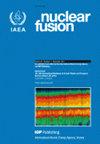Disruption runaway electron generation and mitigation in the Spherical Tokamak for Energy Production (STEP)
IF 4
1区 物理与天体物理
Q1 PHYSICS, FLUIDS & PLASMAS
引用次数: 0
Abstract
Generation of Runaway Electrons (REs) during plasma disruptions is of great concern for ITER and future reactors based on the tokamak concept. Unmitigated RE generation in the current STEP (Spherical Tokamak for Energy Production) concept design is modelled using the code DREAM, with hot-tail generation found to be the dominant primary generation mechanism and avalanche multiplication of REs found to be extremely high. Varying assumptions for the prescribed thermal quench (TQ) phase (duration, final electron temperature) as well as the wall time, the plasma-wall distance, and shaping effects, all STEP full-power and full-current unmitigated disruptions generate large RE beams (from 10 MA up to full conversion). RE mitigation is first studied by modelling idealised mixed impurity injections, with ad-hoc particle transport arising from the stochasticity of the magnetic field during the TQ, but no combination of argon and deuterium quantities allows runaways to be avoided while respecting the other constraints of disruption mitigation. Initial concept of STEP disruption mitigation system is then tested with DREAM, assuming two-stage shattered pellet injections (SPI) of pure球形能源生产托卡马克(STEP)中失控电子的产生与缓解
等离子体中断期间产生的失控电子(REs)是热核实验堆和未来基于托卡马克概念的反应堆非常关注的问题。在当前的 STEP(用于能源生产的球形托卡马克)概念设计中,使用 DREAM 代码对失控电子的产生进行了模拟,发现热尾产生是主要的主要产生机制,并且发现失控电子的雪崩倍增非常高。由于对规定的热淬火(TQ)阶段(持续时间、最终电子温度)以及壁时间、等离子体-壁距离和塑形效应的假设不同,所有 STEP 全功率和全电流未缓解中断都会产生大量 RE 光束(从 10 MA 到全转换)。首先通过模拟理想化的混合杂质注入来研究 RE 减缓问题,TQ 期间磁场的随机性引起了临时粒子传输,但氩和氘的数量组合无法在遵守中断缓解的其他限制条件的同时避免失控。随后,利用 DREAM 对 STEP 干扰缓解系统的初步概念进行了测试,假定先进行纯 D2 后进行 Ar+D2 的两阶段碎裂颗粒注入 (SPI)。结果发现,这种方案可以减少热尾机制产生的 RE,但仍会产生约 13 MA 的 RE 光束。此外,还将讨论进一步优化 SPI 方案、在 STEP(良性终止方案)中减缓大 RE 射束的方案,以及在电流淬火期间所需 RE 损失的估算(来自潜在的被动 RE 减缓线圈)。
本文章由计算机程序翻译,如有差异,请以英文原文为准。
求助全文
约1分钟内获得全文
求助全文
来源期刊

Nuclear Fusion
物理-物理:核物理
CiteScore
6.30
自引率
39.40%
发文量
411
审稿时长
2.6 months
期刊介绍:
Nuclear Fusion publishes articles making significant advances to the field of controlled thermonuclear fusion. The journal scope includes:
-the production, heating and confinement of high temperature plasmas;
-the physical properties of such plasmas;
-the experimental or theoretical methods of exploring or explaining them;
-fusion reactor physics;
-reactor concepts; and
-fusion technologies.
The journal has a dedicated Associate Editor for inertial confinement fusion.
 求助内容:
求助内容: 应助结果提醒方式:
应助结果提醒方式:


